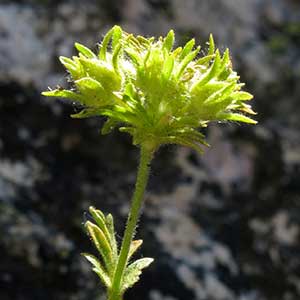Ivesia longibracteata
Ivesia baileyi
Castle Crags ivesia, longbract mousetail
Bailey's ivesia, Owyhee ivesia
ascending to erect, 0.3–1.2 dm.
pendent or prostrate to ascending, 0.5–2(–2.5) dm.
weakly planar to loosely ± cylindric, (0.5–)2–4(–6) cm; sheathing base glandular abaxially, otherwise glabrous;
petiole 0.5–2 cm, hairs 0.2–1 mm;
leaflets 5–6 per side, 2–6 mm, ± short-hirsute, glandular-puberulent, lobes 2–7, oblanceolate to spatulate or obovate, apex not setose.
planar, 3–12(–18) cm; sheathing base not or sparsely strigose abaxially;
petiole 1–8 cm;
lateral leaflets 2–6(–10) per side, separate to slightly overlapping distally, ovate or obovate to flabellate, 4–15(–25) mm, incised 1/4–3/4 to base into 3–11(–15) ovate to oblanceolate teeth or lobes, apex not setose, surfaces ± sparsely short-pilose or hirsute, ± glandular;
terminal leaflets ± distinct.
1–3, not paired.
1–2;
blade reduced.
3–14-flowered, 1–2.5 cm diam.;
glomerules 1.
(1–)5–40-flowered, open, (1–)1.5–8(–10) cm diam.
1.5–6 mm.
2–15(–30) mm.
8–10 mm diam.;
epicalyx bractlets linear to narrowly lanceolate or elliptic, 2.5–5 mm, longer than sepals;
hypanthium shallowly cupulate, 0.5–1 × 2–3 mm;
sepals 1.5–2.5 mm, ± acute;
petals pale yellow, linear to narrowly oblanceolate, 1.5–2.5 mm;
stamens 5, filaments 0.7–1.3 mm, anthers yellow, 0.5–0.8 mm;
carpels 6–11, styles 1–1.5 mm.
4–10 mm diam.;
epicalyx bractlets 5, narrowly lanceolate to ovate, 0.8–2.5 mm;
hypanthium patelliform, 0.5–2 × 2–4 mm;
sepals (1.2–)1.5–4 mm, acute;
petals white or pale yellow, oblanceolate to narrowly spatulate, 1.5–2.5 mm;
stamens 5, filaments 0.5–1.1 mm, anthers yellow, sometimes with reddish margins, oblong, 0.4–0.7 mm;
carpels (1–)3–8, styles 0.9–1.8 mm.
cream to light tan, 1.2–1.5 mm.
greenish white to light tan, 1.5–2 mm, smooth or rugose, ± carunculate.
Ivesia longibracteata
Ivesia baileyi
Of conservation concern.
Ivesia longibracteata is known only from the Castle Crags area of Shasta County. The epithet alludes to a diagnostic characteristic unique in the genus: the epicalyx bractlets are longer than the sepals. The plants grow on vertical rock faces, a habitat more characteristic of sect. Setosae; however, the stems are ascending to erect and do not form hanging clumps, and the pedicels are not curved in fruit.
(Discussion copyrighted by Flora of North America; reprinted with permission.)
Varieties 2 (2 in the flora).
The two varieties accepted here were not recognized by D. D. Keck (1938), who instead treated Ivesia setosa as a variety of I. baileyi. Field investigations confirm that the three entities are reasonably distinct morphologically, with intergradation where their otherwise distinct ranges overlap in central Nevada.
(Discussion copyrighted by Flora of North America; reprinted with permission.)
1. Petals pale yellow; hypanthium interior yellow to golden; epicalyx bractlets ± 3/4 to as long as sepals; achenes smooth. | var. baileyi |
1. Petals white; hypanthium interior pale green or cream to maroon; epicalyx bractlets usually less than 1/2 as long as sepals; achenes rugose. | var. beneolens |


